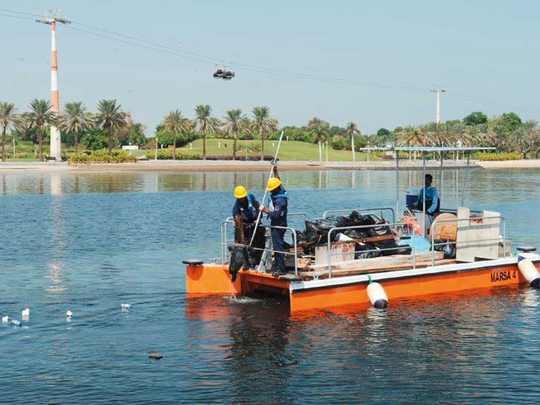
Dubai
Dubai Municipality has enhanced its fleet of waterway clean-up boats and is mulling the launch of a smart, autonomous vehicle that clears rubbish in waterways called “Waste Shark,” the civic body said on Tuesday.
“It is a remote-controlled, autonomous vehicle with dynamic sensors and a smart camera that tracks floating debris and removes them,” said Abdul Majeed Abdul Azeez Al Saifaie, director of the Waste Management Department of the Municipality
“It would improve the quality of work and contribute to the rationalisation of expenditure. It is also environmentally friendly as it is electrically operated and does not release any carbon dioxide,” Saifaie said in a press release.
He was speaking about the future plan for the development of cleaning operations in Dubai’s water channels.
He said these will include the study of a number of modern techniques and equipment used for water purification of the channels, which rely on artificial intelligence and reduce human intervention.
They also use the latest and the most advanced mechanisms to improve performance and efficiency of marine hygiene operations, such as the introduction of a new mechanism called Waste Shark.
He said the Waste Management Department has implemented a range of initiatives and campaigns to keep Dubai’s waterways clean and sustainable, including Dubai Creek, Al Jaddaf Creek, Dubai Water Canal and Business Bay Canal.
They also cover expansions and new waterways such as the waterfront overlooking the fish market and the Deira harbour canal as these places bear tourist, economic and historic importance, he pointed out.
The cleaning of these sites is carried out through a specialised unit which has 50 specialist marine workers and cleaners of water canals.
The maritime fleet of the Unit includes 13 marine vehicles, classified for manual and hydraulic recovery operation, equipped with the latest technologies. In addition, there are a number of marine vehicles to combat disasters and crises and exit to the open sea when absolutely necessary.
In 2017, the unit collected about 1,070 tonnes of waste from these waterways.
This included wood, plastic bags, food wastes, algae, seaweed, shipwrecks, oil residues and waste from the projects executed on the banks of the waterways. The waste resulting from the immediate response to emergencies and marine disasters such as death of fish, ship and cargo fires, and debris from ship collision or drowning was also collected.
Since 2010, the Waterways Cleaning Unit of the Waste Management Department has implemented a number of initiatives and campaigns, such as cleaning the bottoms of waterways and removing the abandoned ships.
These campaigns resulted in the recovery of about 30 tonnes of benthic waste and the lifting and transfer of 63 neglected and sunken ships, which were a navigational danger to water channels such as the risk of collision, the municipality said.












